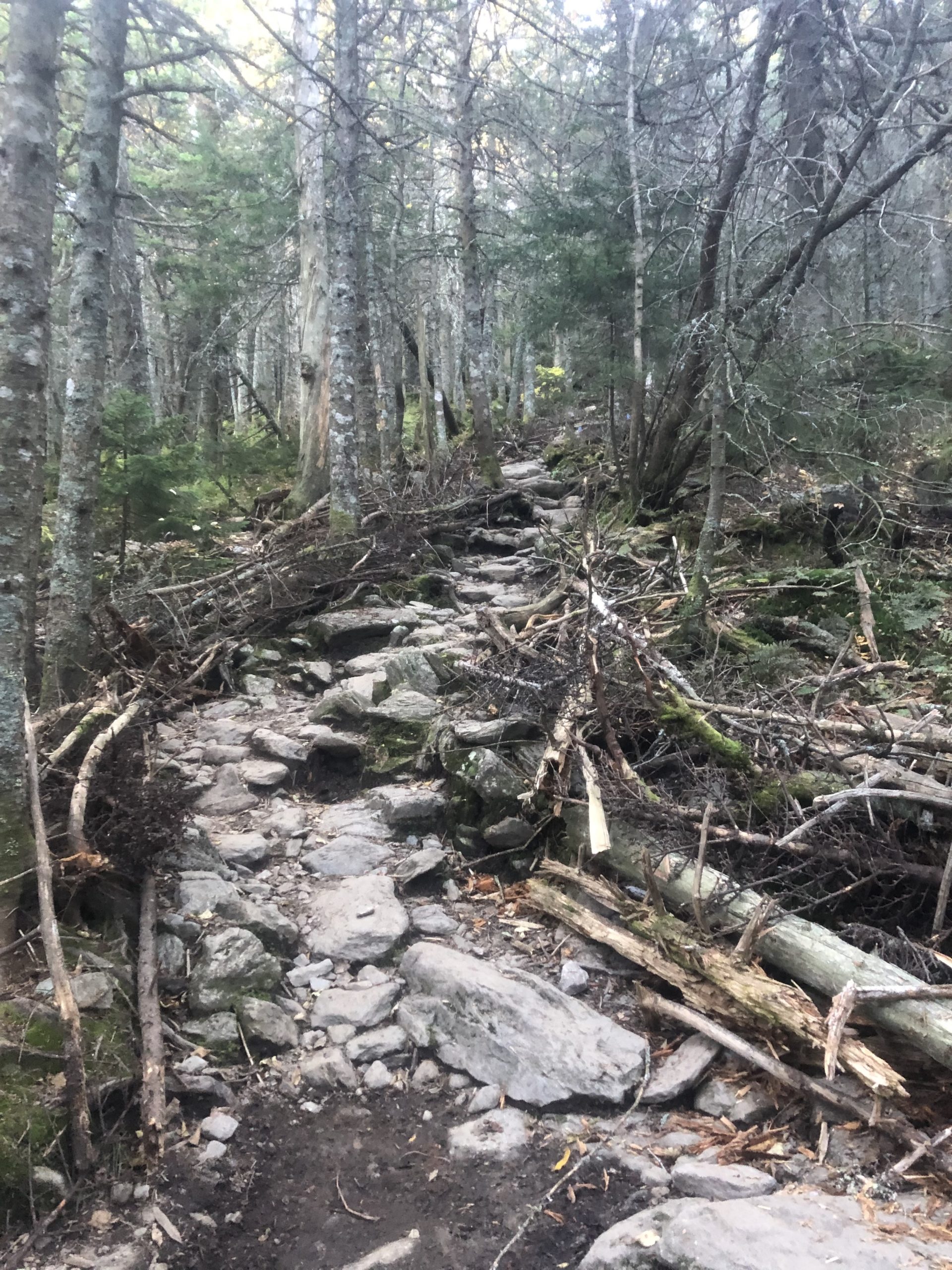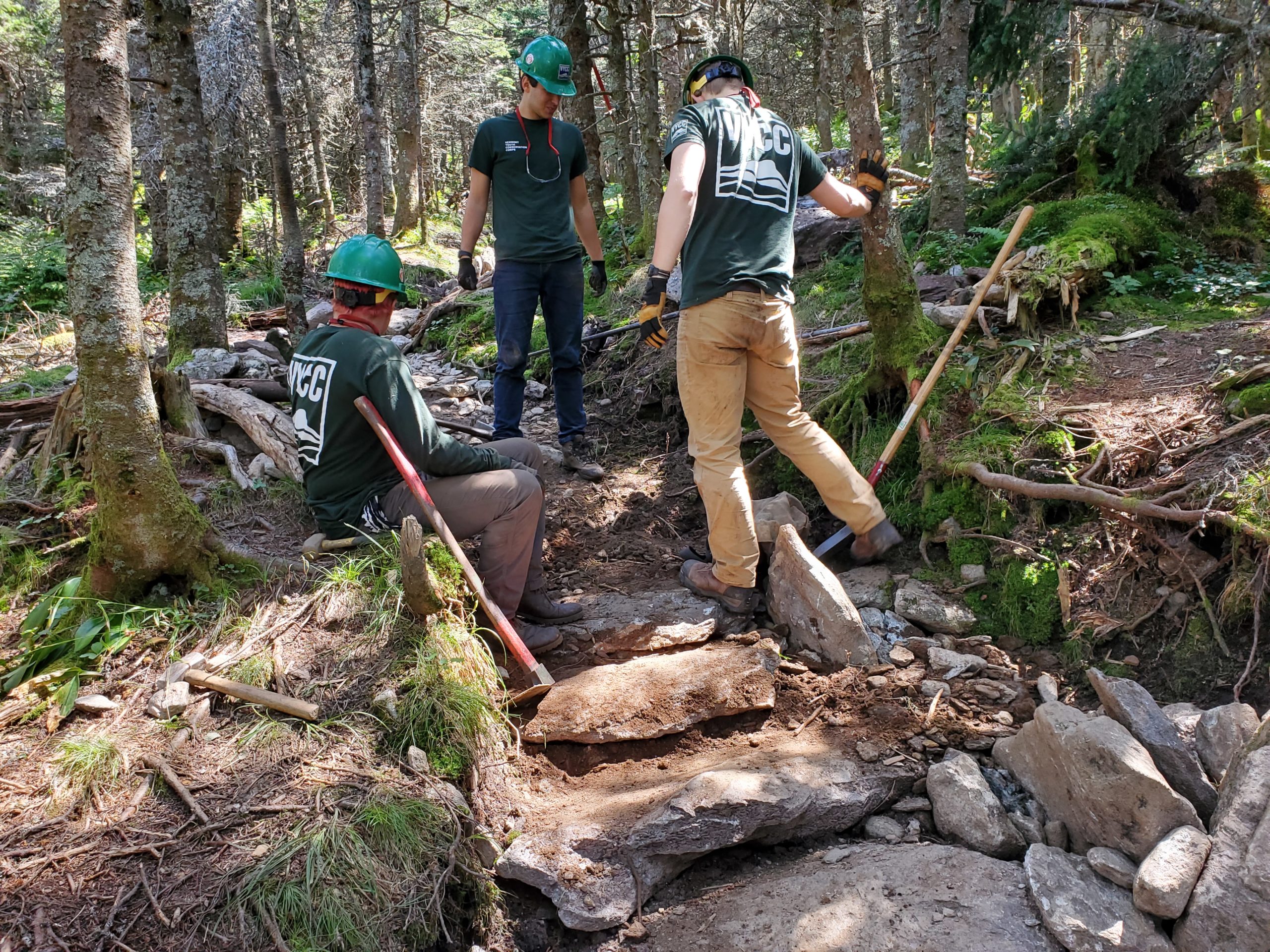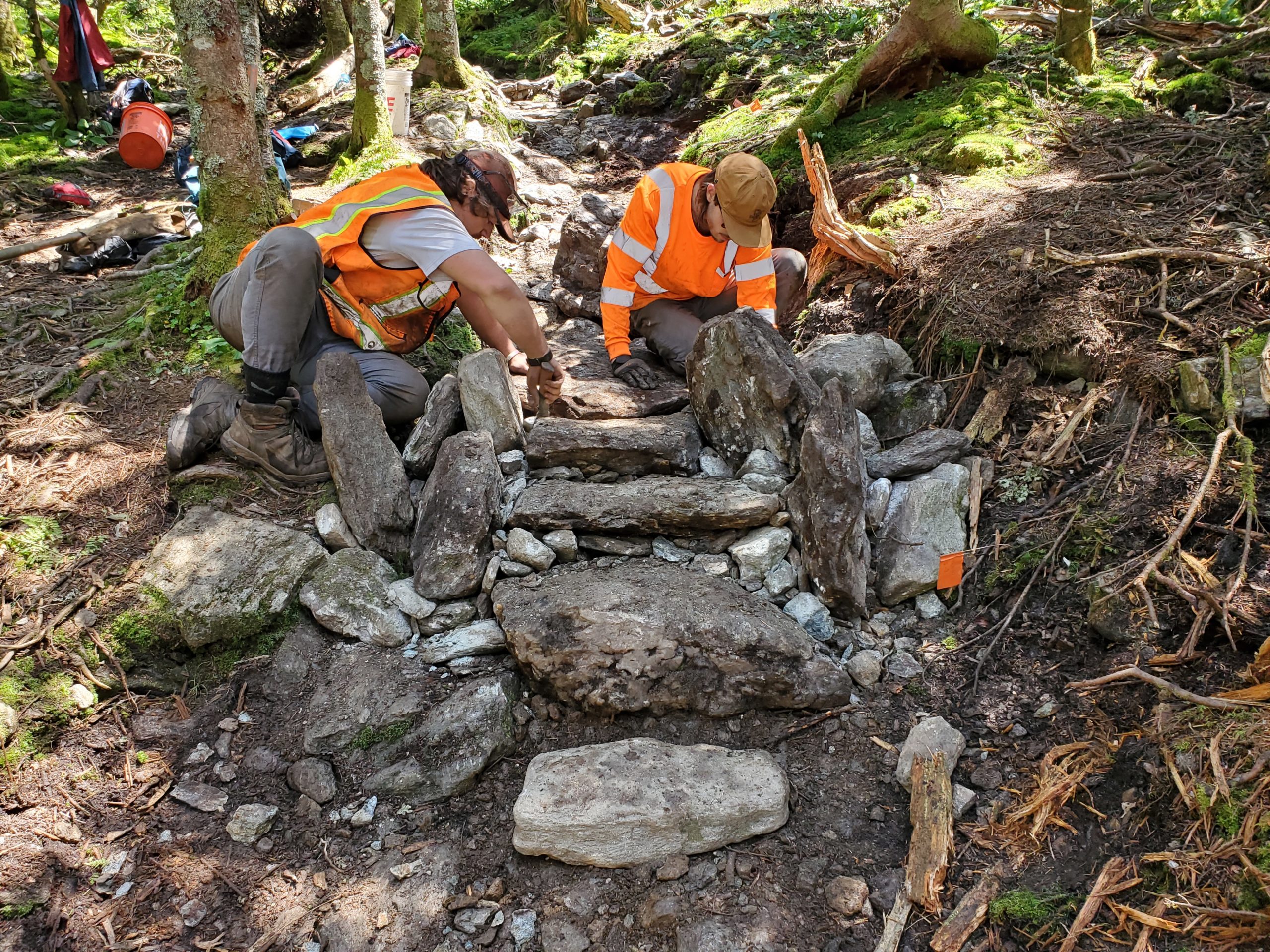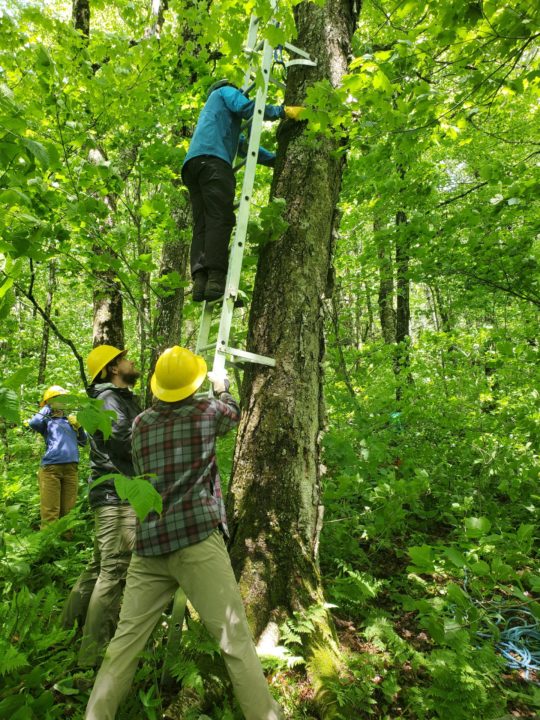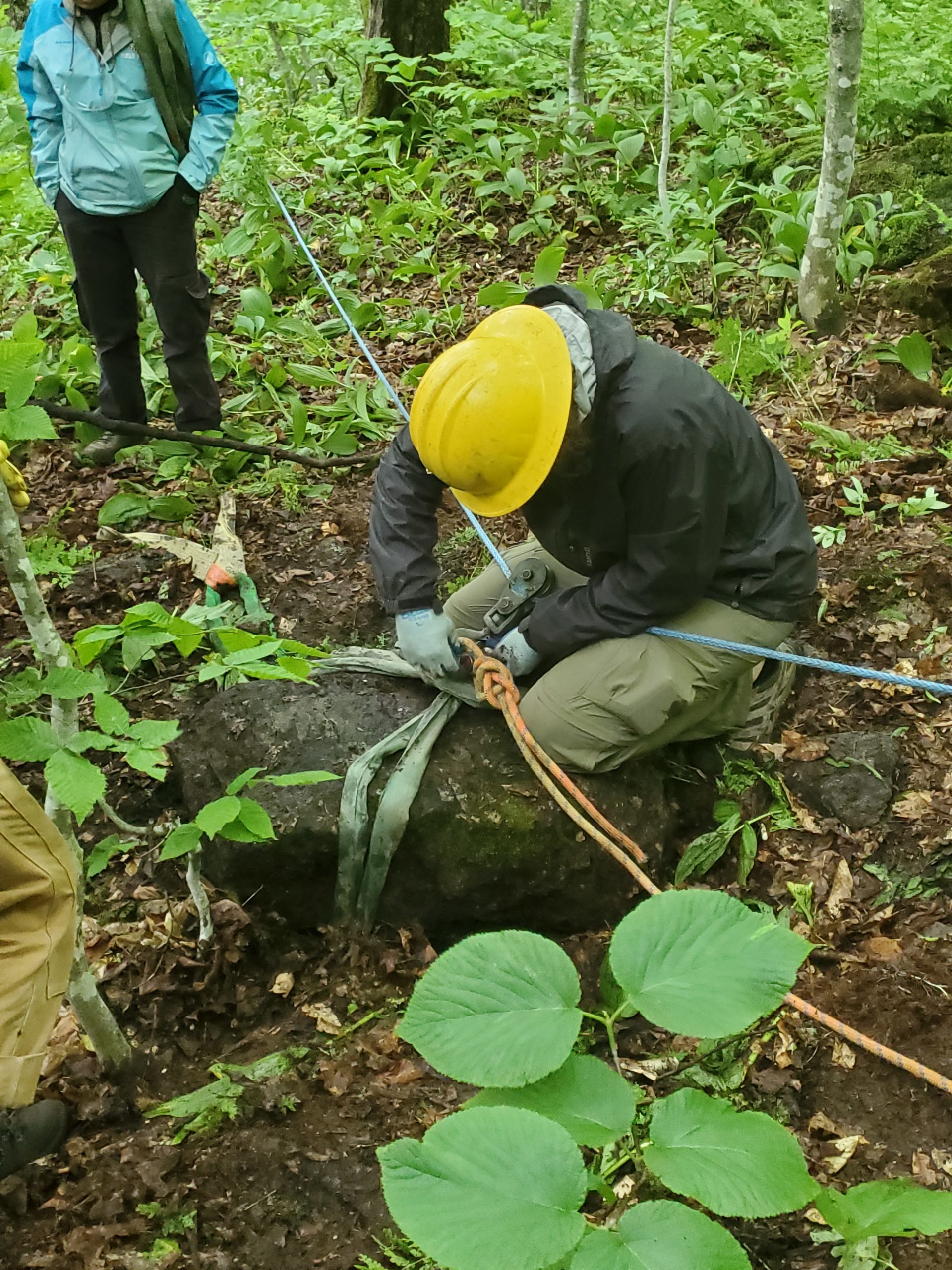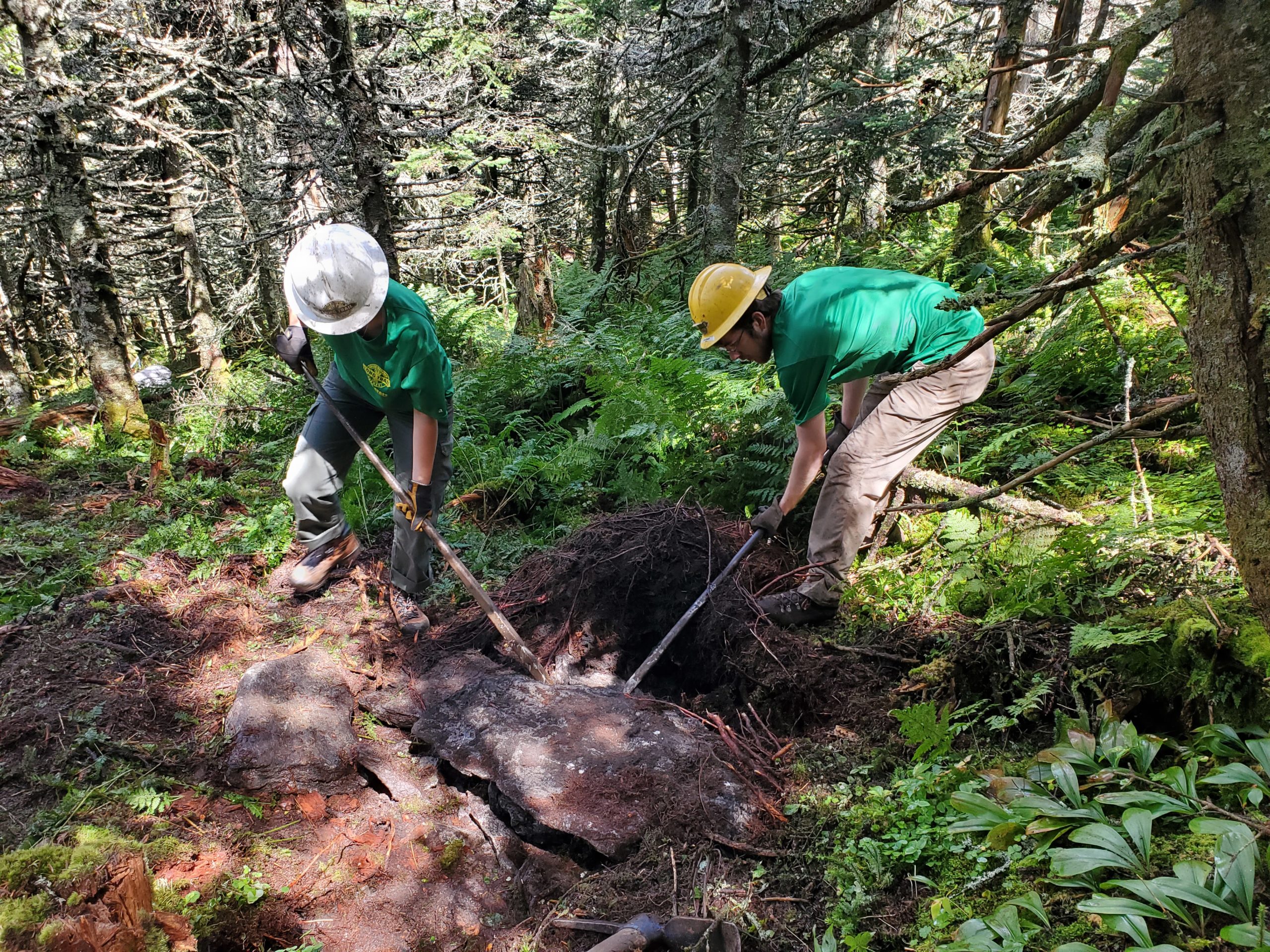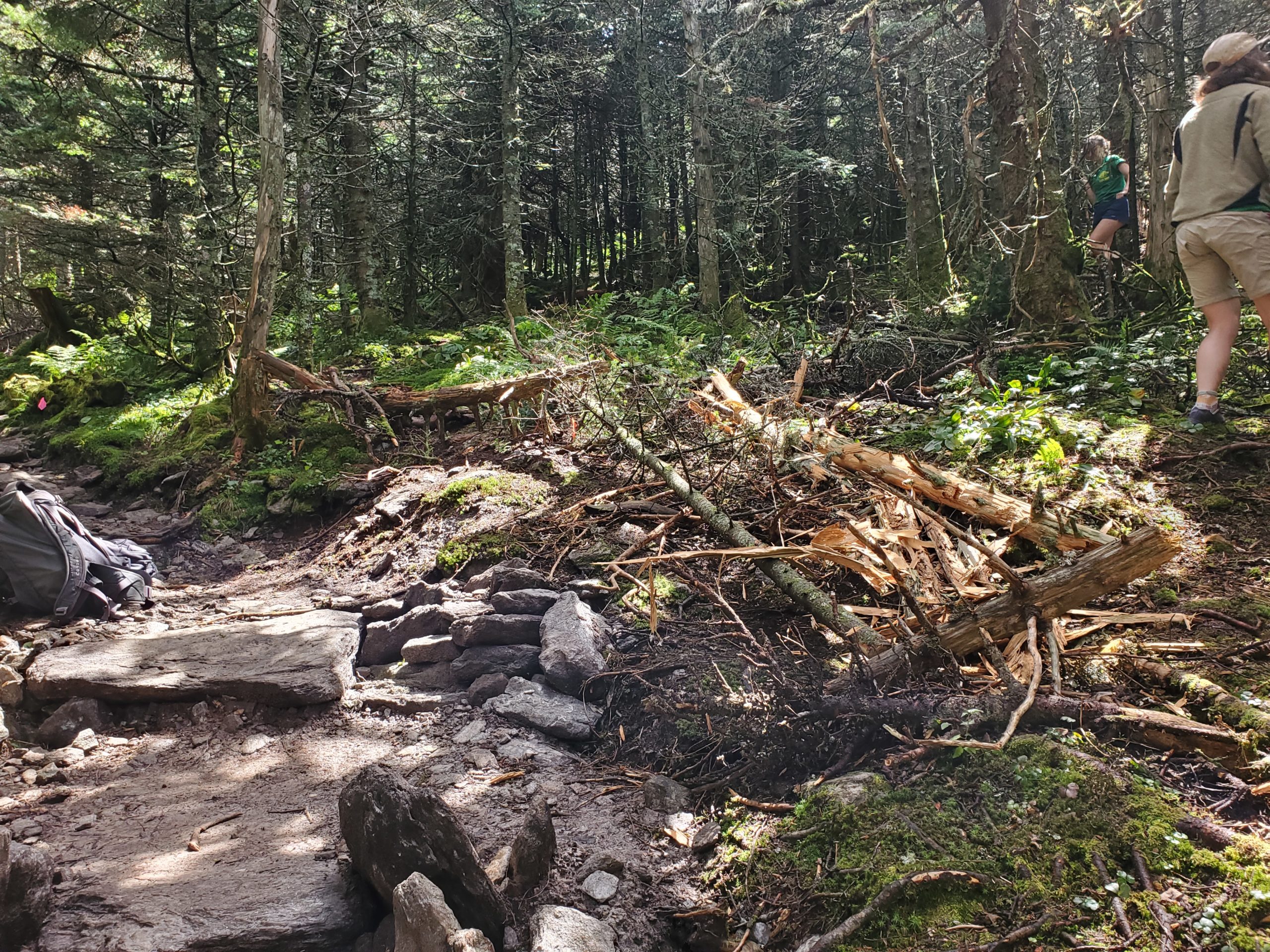 In Summer 2022, work commenced on the three-year long Burrows Trail rehabilitation project. Starting in Huntington, Vermont, the trail runs 2.1 miles up the fall line of the mountain before intersecting the Long Trail to reach the summit of Camel’s Hump. Burrows Trail was built more than 100 years ago, and has not seen such extensive maintenance before. It has been heavily eroded by water running down the trail, turning it into a gulley in some areas. Much of the trail has also become excessively widened, due to heavy hiker and dog traffic.
In Summer 2022, work commenced on the three-year long Burrows Trail rehabilitation project. Starting in Huntington, Vermont, the trail runs 2.1 miles up the fall line of the mountain before intersecting the Long Trail to reach the summit of Camel’s Hump. Burrows Trail was built more than 100 years ago, and has not seen such extensive maintenance before. It has been heavily eroded by water running down the trail, turning it into a gulley in some areas. Much of the trail has also become excessively widened, due to heavy hiker and dog traffic.
In Fall 2024, the Burrows Trail Project was complete. It took 70 weeks of work from crews from several different organizations. The newly rebuilt trail includes dozens of stone staircases and chesksteps, rehabilitated waterbars, and two short relocations on the lower portion of the trail.
Historically, due to limited funding and crew capacity, FPR and GMC have taken an ad-hoc, patch-it-up approach to trail work. But the Burrows Trail presented the opportunity to invest unprecedented funding and capacity and rebuild the whole trail at once, improving its durability and resilience to the combined impacts of severe rainfall and hiker traffic. By starting at the top of the trail, the improved drainage structures at the top also protected the lower portion of the trail from more severe damage during the flooding in 2023 and 2024. Read more about the project’s completion.
This project is a joint effort with Vermont Forests, Parks, and Recreation and other local partners.
Burrows Trail project in the news:
- Green Mountain Club celebrates rehabilitation of a popular Camel’s Hump trail, VT Digger, October 24, 2024
- Restoration of popular Vermont hiking trail complete, WCAX, October 11, 2024
- Popular Vt. hiking trail has new look after summer renovations, WCAX, October 13, 2022
- A Mid-Season Report on the Historic Burrows Trail Rehabilitation, first published in the Fall 2022 Long Trail News
- Press Release: Green Mountain Club and FPR to Invest $460,000 to Rebuild the Popular Burrows Trail on Camel’s Hump
- Green Mountain Club plans complete overhaul of popular Camel’s Hump hiking trail, VTDigger, May 3, 2022
- Green Mountain Club plans revitalization of Camel’s Hump Trail, NBC5, May 4, 2022
- Burrows Trail on Camel’s Hump to be renovated, My Champlain Valley, May 4, 2022
- Camel’s Hump’s Burrows Trail to see major upgrades, WCAX 3, May 5, 2022
Explore the Burrows Project:
What’s with all those piles of sticks along the edge of the trail?
That’s a brush-in, a valuable trail maintenance feature, and the awesome AmeriCorps NCCC crew brushed in over 55 areas along the trail during their 5 weeks working on the Burrows Trail project.
A brush-in, according to GMC’s trail maintenance handbook, is a useful tool to address areas of widening or “social trails,” where hikers have created multiple footpaths on either side of the designated treadway. Burrows Trail is full of excessive widening and social trails that result from hikers looking for an easier way around an obstacle or around other hikers. We’re tackling this issue by a) improving and repairing areas with deep erosion or too-big steps or stairs and b) closing off the areas of widening with brush-ins.
A brush-in has a few layers and steps to do properly. First, trail maintainers aerate the compacted soil of the undesirable tread, so that seeds and new growth can get started in the area. Then, they spread organic materials and “duff” on top, to help concentrate future vegetation growth. Duff consists of leaves, pine needles, twigs, moss, ferns, etc. Harvested from well off the trail.
Then, the obvious part: maintainers gather and stack heavy logs, downed tree crowns, noticeably sharp twigs and branches, and rocks to make that part of trail extremely undesirable to walk on. These things should be big, heavy, ugly, hard to move, and bigger than you might expect to serve their purposes effectively. Their purpose is to make it difficult or impossible to walk off trail, and therefore will keep hikers on the intended trail.
Maintainers do their best to make a brush-in blend in with the woods, but this will occur naturally over time as regrowth begins and the elements of the brush-in break down.
The brush-ins on Burrows are obvious because 1) there are a LOT of them. FPR and GMC identified 117 areas of excessive width along the 2.1-mile trail, and the NCCC crew made quick work of over 55 of them in their 5 weeks on the project! And 2) These brush-ins were done properly! A proper new brush-in will be very visible for the first several weeks/months after it is constructed.
The Burrows project is ongoing, and we do our best to minimize the impact to hikers as this construction happens.
The Burrows Trail Project is a large-scale example of the important work done thanks to partnerships across public land in Vermont. Every year the Green Mountain Club, Vermont Forests Parks and Recreation, and many other groups work together on projects across the state to ensure continued public recreation access. During the week of July 11, all hands were on deck on Burrows as the Vermont State Trail Crew joined GMC’s Long Trail Patrol crew for the week, rebuilding water bars and installing check steps to slow water erosion at the top of the trail.
The week of August 15 is the first of eight weeks of work the Vermont Youth Conservation Corps (VYCC) Pro Crew is putting in with GMC’s Long Trail Patrol crew, helping to build staircases, waterbars, and check steps. The crews are working together as one team, which gives them the perfect opportunity to engage with and learn from each other.
Other local partners, including, NorthWoods Stewardship Center Conservation Corps, National Community Conservation Corps, and volunteers will be contributing later this summer as well.
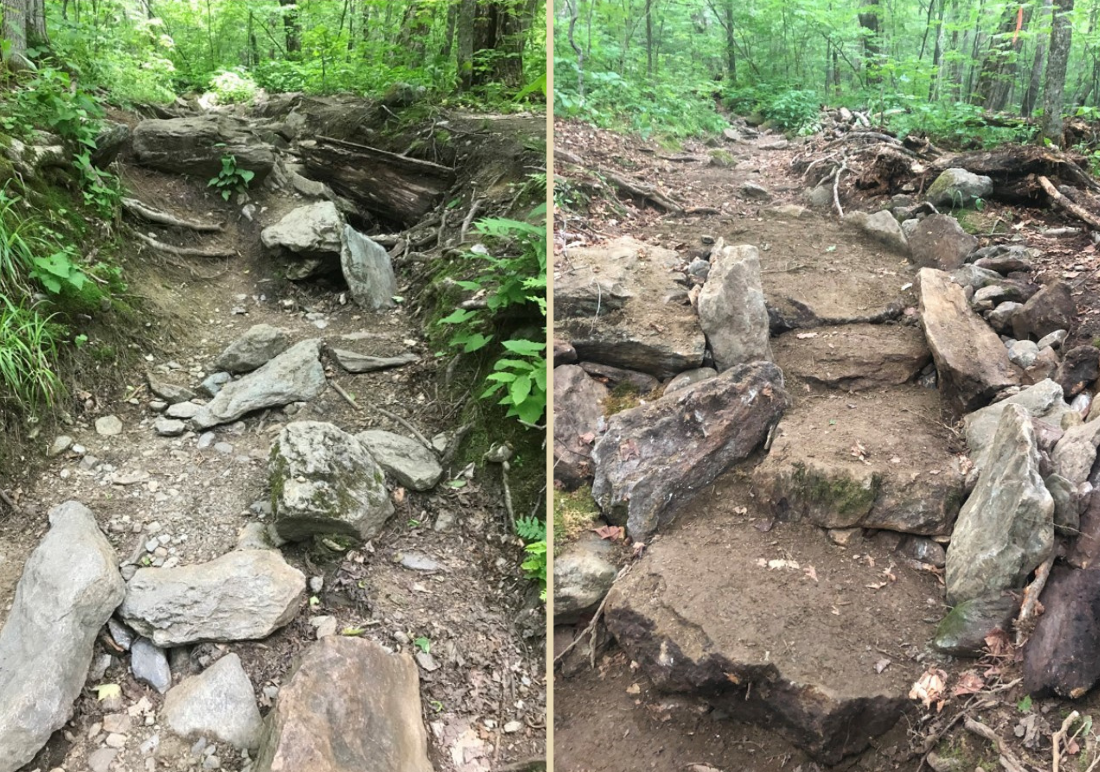
[Week of June 13] The above photos show a section of the Burrows Trail before and after a stone staircase was constructed. Before, the trail was heavily eroded, steep, and difficult for hikers to pass. Crews used rock bars and a highline to move these rocks to the location on the trail. Now, the trail is less susceptible to erosion and easier for hikers!
GMC Long Trail Patrol Crews use highlines to safely and easily move rocks weighing hundreds of pounds across long distances. First, they rig up a long rope (highline) between two trees. After harvesting the perfect-sized rock, they harness it up and hook it onto the highline. A griphoist is used to create tension on the highline, lifting the rock into the air. The rock can now travel down the highline! It can then be put into place to build a staircase or a check step, which will make the climb easier for hikers and mitigate erosion.
[Week of June 20] GMC Long Trail Patrol crew installed the first of many sets of check steps near the Hut Clearing on Burrows Trail! In areas where the trail has been heavily eroded and is essentially in a gulley, check steps help to restore the level of the trail and mitigate erosion. First, the crew harvests a wide, flat rock to use as a check step. Then they dig a shallow hole in the ground, creating a stable place for the rock to sit. They take precision to set into the ground just right; the crew must find solid points of contact to ensure the step is in place for decades to come. Crushed rocks are placed around the check step to fill in gaps, even out the surface, and prevent erosion, and mineral soil is spread around the step to allow water to run off the trail. These check steps make the trail more friendly to hikers and less susceptible to erosion!
[Week of June 28] GMC Long Trail Patrol crew repaired a waterbar on Burrows Trail! A waterbar is a commonly used feature that is designed to divert water off the trail. The previous waterbar was faulty, as it was full of sediment and the rocks were no longer creating a dam. First, crews dig out the sediment, creating a place for new rocks to be positioned. Then, they carefully put the rocks in place, making sure they’re contacting each other and creating an effective drainage structure. Crushed rocks are placed around the waterbar to fill in gaps and help mitigate erosion. Lastly, check steps are placed in front of the waterbar, allowing hikers to easily pass over it!
GMC caretakers – who live along the trail for the hiking season to answer hiker questions, educate around alpine zones, and assist with light infrastructure upkeep – moseyed down from Mt. Mansfield and Camel’s Hump to join the Long Trail Patrol (LTP) crew on Burrows Trail for a day! The LTP do sophisticated trail projects along the whole of the Long Trail. Caretakers assisted the crew with clearing water drainage and brushing in, a technique in which dead trees and sticks are placed alongside the trail to discourage hikers from going off trail.
You may have walked on the stairs and steps that trail crews build to limit erosion on trails, but where do they get those giant slabs of rock? Crews harvest rocks from nearby quarry sites they find off trail, which are located out of sight as to not be an eyesore. Then, crews highline rocks down to the trail instead of dragging them across the mossy landscape.
If you’ve hiked Burrows Trail recently, you’ve walked up some of the new staircases that crews have built to keep hikers on durable surfaces and minimize soil erosion. The stone staircases blend pretty seamlessly in with the environment. However, when trail erosion is so bad that all that is left is a sheer rock face, stone staircases are impossible to build into the landscape. So, they installed a wooden staircase, filled with crushed rock from the surrounding environment, to provide an even stepping surface for hikers.
Follow GMC on Instagram and Facebook for Burrows updates all summer long.



